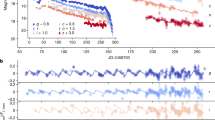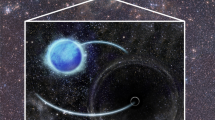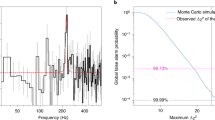Abstract
X-RAY novae are binary systems in which a compact object accretes gas from a companion star. In several cases there is good evidence that the compact object is a black hole1–5. The best evidence for the presence of a black hole comes from measuring the orbital velocity of the companion star and thereby determining the minimum mass of the compact object; when this mass exceeds the maximum mass for a neutron star (≲3 solar masses6), a black hole seems the only remaining possibility. The unusual X-ray nova GRO J1655 - 40 (refs 7-10) is unique because it emits superlumi-nal radio jets, suggesting that it is a low-luminosity counterpart to active galactic nuclei7,9, which are thought to be powered by accretion onto a massive black hole. Here we report observations of the optical counterpart10 of GRO J1655 - 40, which show that the system undergoes periodic eclipses; the edge-on geometry thus implied allows a determination of the companion star's true velocity. The mass of the compact object derived from the velocity curve is at least 3.16 ±0.15 solar masses, which strongly supports its identification as a black hole.
This is a preview of subscription content, access via your institution
Access options
Subscribe to this journal
Receive 51 print issues and online access
$199.00 per year
only $3.90 per issue
Buy this article
- Purchase on Springer Link
- Instant access to full article PDF
Prices may be subject to local taxes which are calculated during checkout
Similar content being viewed by others
References
McClintock, J. E. & Remillard, R. A. Astrophys. J. 308, 110–122 (1986).
Casares, J., Charles, P. A. & Naylor, T. Nature 355, 614–617 (1992).
Remillard, R. A., McClintock, J. E. & Bailyn, C. D. Astrophys. J. 399, L145–L149 (1992).
Remillard, R. A., McClintock, J. E., Orosz, J. A. & Bailyn, C. D. Astrophys. J. (in the press).
Charles, P. A. & Casares, J. IAU Circ. No. 2498 (1995).
Chitre, D. M. & Hartle, J. B. Astrophys. J. 207, 592–600 (1976).
Tingay, S. J. et al. Nature 374, 141–143 (1995).
Harmon, B. A. et al. Nature 374, 704–706 (1995).
Hjellming, R. M. & Rupen, M. P. Nature 375, 464–468 (1995).
Bailyn, C. D. et al. Nature 374, 701–703 (1995).
Bailyn, C. D. Astrophys. J. 391, 298–305 (1992).
Callanan, P. J. et al. Astrophys. J. 441, 785–799 (1995).
Cowley, A. P., Schmidtke, P. C., Crampton, D. & Hutchings, J. B. Astrophys. J. 350, 288–294 (1990).
Horne, K. Mon. Not. R. astr. Soc. 213, 129–141 (1985).
Tonry, J. & Davis, M. Astr. J. 84, 1511–1525 (1979).
Brandt, W. N., Podsiadlowski, Ph. & Sigurdsson, S. Mon. Not. R. astr. Soc. (in the press).
Arnett, W. D. & Bowers, R. L. Astrophys. J. Suppl. Ser. 33, 415–436 (1978).
Filippenko, A. V. Publs astr. Soc. Pacif. 94, 715–721 (1982).
Crampton, D. & Hutchings, J. B. Astrophys. J. 191, 483–491 (1974).
Marsh, T. R., Robinson, E. L. & Woods, J. H. Mon. Not. R. astr. Soc. 266, 137–154 (1994).
Orosz, J. A., Bailyn, C. D., Remillard, R. A., McClintock, J. E. & Foltz, C. B. Astrophys. J. 436, 848–858 (1994).
Warner, B. in Interacting Binary Stars (eds Eggleton, P. P. & Pringle, J. E.) 367–392 (NATO ASI Ser., Reidel, Dordrecht, 1985).
Author information
Authors and Affiliations
Rights and permissions
About this article
Cite this article
Bailyn, C., Orosz, J., McClintock, J. et al. Dynamical evidence for a black hole in the eclipsing X-ray nova GRO J1655 – 40. Nature 378, 157–159 (1995). https://doi.org/10.1038/378157a0
Received:
Accepted:
Issue Date:
DOI: https://doi.org/10.1038/378157a0
Comments
By submitting a comment you agree to abide by our Terms and Community Guidelines. If you find something abusive or that does not comply with our terms or guidelines please flag it as inappropriate.



